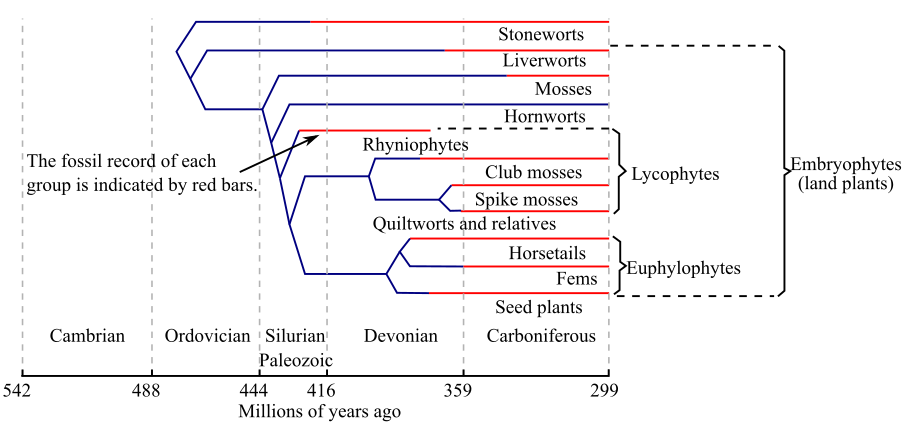
Life: The Science of Biology
11th Edition
ISBN: 9781319010164
Author: David E. Sadava, David M. Hillis, H. Craig Heller, Sally D. Hacker
Publisher: W. H. Freeman
expand_more
expand_more
format_list_bulleted
Concept explainers
Question
Chapter 27, Problem 4Q
Summary Introduction
To review:
The time and the geological period when the last common ancestor of embryophytes lived, and also the significant change in the life history that had occurred in this lineage.
Given:
Figure 1 shows the geological timescale of the origin of various embryophytes (land plants) including ferns and seed plants.
Figure 1: The geological timescale of the origin of various embryophytes.

Introduction:
Land plants are sometimes referred to as ‘Embryophytes’ because these plants develop from embryos protected by parental tissue. These plants generally arose from the aquatic green algal ancestor that is found linked with today’s stonewort.
Expert Solution & Answer
Want to see the full answer?
Check out a sample textbook solution
Students have asked these similar questions
What are leaves? what are the two types? What is the difference between homosporous plants and heterosporous plants? What are megaspores and microspores? What was significance of the ecological role of seedless vascular plants back when they dominated terrestrial habitats? Why is that so important to our modern world today?
Do mosses have an alternation of isomorphic or heteromorphic generations? That is, can you easily tell a moss gametophyte from a moss sporophyte? When we look at leafy green moss plants, what are we seeing—the gametophyte or the sporophyte? In a flowering plant species, would the equivalent stage be the plant or the pollen grains and megagametophytes?
Do mosses have an alteration of isomorphIC Or heteromorphic generations? That is, can youeasily tell a moss gametophyte from a moss sporophyte? When we look at leafy green mossplants, what are we seeing - gametophyte or the sporophyte? in a fiowering plant species,would the equivalent stage be the plant the pollen grains and megagametophytes
Knowledge Booster
Learn more about
Need a deep-dive on the concept behind this application? Look no further. Learn more about this topic, biology and related others by exploring similar questions and additional content below.Similar questions
- which plant family often has a basal rosette of leaves and a well-developed hypanthium?arrow_forwardThe non-vascular plants are represented today by three phyla of small herbaceous plants namely: Phylum Hepatophyta, Phylum Anthocerophyta, and Phylum Bryophyta. Cite and explain how the structure fits function in bryophytesarrow_forwardIdentify four derived traits that distinguish plants from charophyte green algae and facilitate life on land. Explain.arrow_forward
- There are two alternative hypotheses about the life cycle of the early vascular plants, the transformation hypothesis and the interpolation hypothesis. If Rhynia and Sciadophyton are the two generations of one species, which hypothesis would be favored? Briefly describe the other hypothesis.arrow_forwardUnder the topic colonization of land plants, land plants are said to have derived traits which include walled spores produced in sporangia. How does this differentiate from similar traits in charophytes?arrow_forwardGreen algae are believed to be the ancestors of the bryophyte. Cite four distinct lines of evidence to support this belief.arrow_forward
- Why are pteridophytes better adapted to dry land than bryophytes? Were Pteridophytes always less abundant than phanerogamic plants?arrow_forwardTrimerophytes were plants that probably evolved from rhyniophytes but with more derived features. In one feature, certain stems grow longer than others, and thus, rather than having dichotomous branching, they have branching (displayed especially by Pertica). Simultaneously, the positioning of branches became more and .arrow_forwardMonilophytes and seed plants both have megaphylls, as well as other traits not found in lycophytes. Explain this observation using the Figure in the picture and the concept of descent with modification.arrow_forward
- Which two structures evolved though a series of changes in the reproductive biology among some heterosporous plants during the late Devonian period allowed spermatophytes (seed plants) to reduce or eliminate their dependence on water for gamete fertilization and development of the embryo and allowed them to colonize a much wider range of habitats?arrow_forwardWhat is the evolutionaryimportance of pteridophytes?arrow_forwardAre mosses a direct ancestor of flowering plants? Explain.arrow_forward
arrow_back_ios
SEE MORE QUESTIONS
arrow_forward_ios
Recommended textbooks for you
 Human Anatomy & Physiology (11th Edition)BiologyISBN:9780134580999Author:Elaine N. Marieb, Katja N. HoehnPublisher:PEARSON
Human Anatomy & Physiology (11th Edition)BiologyISBN:9780134580999Author:Elaine N. Marieb, Katja N. HoehnPublisher:PEARSON Biology 2eBiologyISBN:9781947172517Author:Matthew Douglas, Jung Choi, Mary Ann ClarkPublisher:OpenStax
Biology 2eBiologyISBN:9781947172517Author:Matthew Douglas, Jung Choi, Mary Ann ClarkPublisher:OpenStax Anatomy & PhysiologyBiologyISBN:9781259398629Author:McKinley, Michael P., O'loughlin, Valerie Dean, Bidle, Theresa StouterPublisher:Mcgraw Hill Education,
Anatomy & PhysiologyBiologyISBN:9781259398629Author:McKinley, Michael P., O'loughlin, Valerie Dean, Bidle, Theresa StouterPublisher:Mcgraw Hill Education, Molecular Biology of the Cell (Sixth Edition)BiologyISBN:9780815344322Author:Bruce Alberts, Alexander D. Johnson, Julian Lewis, David Morgan, Martin Raff, Keith Roberts, Peter WalterPublisher:W. W. Norton & Company
Molecular Biology of the Cell (Sixth Edition)BiologyISBN:9780815344322Author:Bruce Alberts, Alexander D. Johnson, Julian Lewis, David Morgan, Martin Raff, Keith Roberts, Peter WalterPublisher:W. W. Norton & Company Laboratory Manual For Human Anatomy & PhysiologyBiologyISBN:9781260159363Author:Martin, Terry R., Prentice-craver, CynthiaPublisher:McGraw-Hill Publishing Co.
Laboratory Manual For Human Anatomy & PhysiologyBiologyISBN:9781260159363Author:Martin, Terry R., Prentice-craver, CynthiaPublisher:McGraw-Hill Publishing Co. Inquiry Into Life (16th Edition)BiologyISBN:9781260231700Author:Sylvia S. Mader, Michael WindelspechtPublisher:McGraw Hill Education
Inquiry Into Life (16th Edition)BiologyISBN:9781260231700Author:Sylvia S. Mader, Michael WindelspechtPublisher:McGraw Hill Education

Human Anatomy & Physiology (11th Edition)
Biology
ISBN:9780134580999
Author:Elaine N. Marieb, Katja N. Hoehn
Publisher:PEARSON

Biology 2e
Biology
ISBN:9781947172517
Author:Matthew Douglas, Jung Choi, Mary Ann Clark
Publisher:OpenStax

Anatomy & Physiology
Biology
ISBN:9781259398629
Author:McKinley, Michael P., O'loughlin, Valerie Dean, Bidle, Theresa Stouter
Publisher:Mcgraw Hill Education,

Molecular Biology of the Cell (Sixth Edition)
Biology
ISBN:9780815344322
Author:Bruce Alberts, Alexander D. Johnson, Julian Lewis, David Morgan, Martin Raff, Keith Roberts, Peter Walter
Publisher:W. W. Norton & Company

Laboratory Manual For Human Anatomy & Physiology
Biology
ISBN:9781260159363
Author:Martin, Terry R., Prentice-craver, Cynthia
Publisher:McGraw-Hill Publishing Co.

Inquiry Into Life (16th Edition)
Biology
ISBN:9781260231700
Author:Sylvia S. Mader, Michael Windelspecht
Publisher:McGraw Hill Education
DIVERSITY IN PLANTS; Author: 7activestudio;https://www.youtube.com/watch?v=uJrks56FQIY;License: Standard YouTube License, CC-BY
Biology- Plant Kingdom - Diversity in Living Organisms - Part 4 - English - English; Author: Bodhaguru;https://www.youtube.com/watch?v=QFgQ74EvfDQ;License: Standard YouTube License, CC-BY